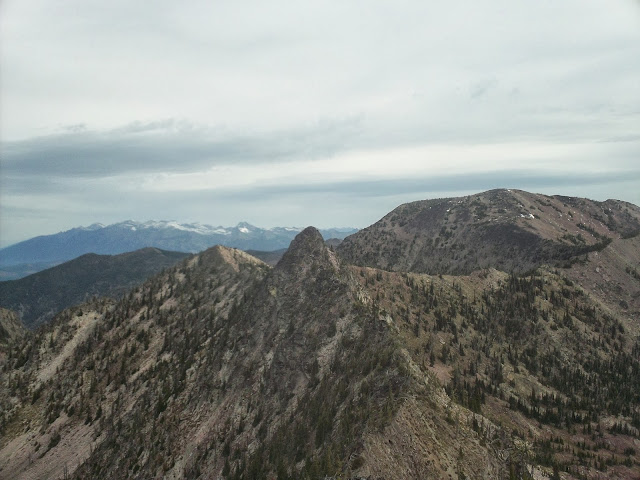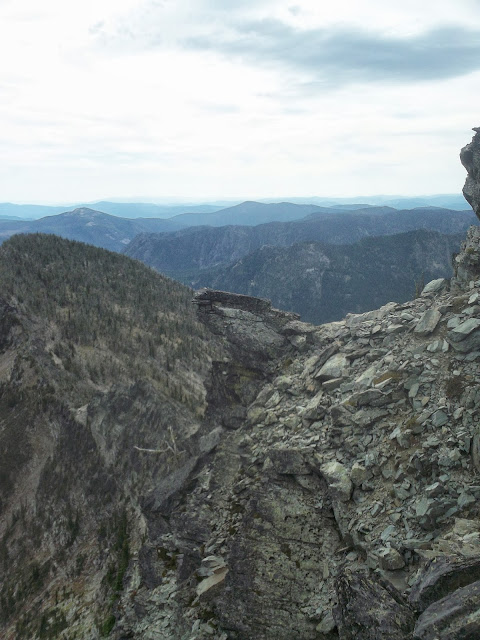On Saturday, I ran the Rut 50k in 6:05:43, which was enough for 8th place. I had a really good time on this beautiful and difficult course, and I learned a great deal about how to train to do better next time and what some of my stronger and weaker skill sets are. This being my first race ever (not just ultras; this was the first footrace of my life), I couldn't (reasonably) be any happier. It happened like this.
Molly and I, having camped up Swan Creek, a big trib of the Gallatin, woke up at 4:45 to a solid drizzle, and I made a quick breakfast of 4 slices of bacon, some delicious Quebecois full strength yogurt (Liberte Brand), and a healthy scoop of nut butter. We made the short drive up to the Big Sky base area, and picked up a bag of decent quality schweg as well as my race number, which was 23. We sat around in the nice lodge, and I drank too much tea. Mike the RD announced that lightning considerations were sufficiently tolerable to keep the climb up to Lone Peak as part of the course (there had been some doubt in the previous days.
Two minutes before the race start, people were still milling around, with a few people tentatively drifting towards the inflatable starting arch. I felt presumptuous for doing it, but there was nobody really lined up at the front yet, so that's where I positioned myself (I gather that the front is usually where people who think they're going to win stand). When the race started, I got excited and went out with the front runners, Pocatello's Luke Nelson setting the pace. I even managed to stay with them for most of the first 1400' climb, but then I got dropped when we topped out on a flat road. This section was pretty short, and then the race dropped down some steepish, pretty rocky single track that was a blast. I made up a bit of time here, getting some of the leaders in view again, but they dropped me again when the course flattened out onto a vaguely downhill access road threading through some Moonlight Basin vacation properties.
I was in eight-ish around this point and I didn't see anyone else for another six miles, well after the first aid station (which I didn't stop at because I had plenty of food and water). Sometime around Mile 11, the eventual winner, Paul Hamilton, caught up with me and loped past effortlessly. At the time, I thought that I had slowed down, but it turns out that he was just moving really fast. I managed to maintain my position all the way to the next aid station, even passing someone on a short stretch of rocky downhill, although Brian Story and two others were creeping up on me and we ended up all reaching the Lone Peak tram dock around the same time.
I again made up a bunch of time running back downhill to the base of Bonecrusher ridge. I had recognized at this point that I was generally slower on the flats and climbs than my pursuers, but notably faster on the descents. I decided that leveraging this on the descent off of Lone Peak was probably wiser than blowing up trying to move too quickly to the summit, and maintained a pretty relaxed hiking pace to the top. I was feeling it in my legs from the long, moderate switchbacking climb up to the tram dock, and in my lungs from the altitude (I never do any sustained running above 9000' while training in Missoula). I got passed three times on the 2100' ascent to Lone Peak, but I made it to the summit within a minute of all of those that had passed me. By the way, the ascent of Bonecrusher ridge must be one of the gnarlier sections of trail to be found in an American trail race, not that I have a basis for comparison. It hits 40+ degrees towards the summit, with loose rock and good exposure off the right-hand side. The wind was blowing, and the cloud deck made me feel like I was mountain climbing rather than racing.
At the summit aid station, I learned that I was 30 minutes or so behind the front of the pack. Obviously no chance of making that up with 12 miles to go, but it felt nice to hear that we weren't getting completely smoked. I drank some Coca-Cola and started down the rocky, technical southeast ridge. I consciously pushed hard down the ridge, taking some risks on the loose and wet rock (interesting geology through this section by the way). I passed four people during the descent, and got a bunch of rocks in my shoes from scree-skiing down a little gully. By the time I hit some flatter terrain towards the bottom, I had put at least 2 or 3 minutes on my nearest pursuer, time that I knew I would need to maintain my position if patterns from earlier in the day held.
I reached the base of some lift (Swiftcurrent?) and a guy there told me that it was mostly jeep tracks to the finish. This was not strictly true, but there were jeep tracks for a while. I kept catching glimpses of Jeff Rome in front of me (and would for the remainder of the race), but was never able to make up any time on him. Not much happened for the next five miles. Some moderately ascending roads gave way to some moderately descending single-track. The ascent of Andesite Mountain to the last aid station was easy and fast, with the exception of the ascent of the Africa mountain bike trail, which included sections of clawing up near vertical mud walls. I don't know how a person rides down it. Someone had almost caught up with me before this bit, but I managed to put up a bit more of a lead through here and hit the final aid station with a reasonably comfortable pad. The volunteers at all of the aid stations were wonderful, but these ones had been so nice as to learn my name, which was a surprising boost (to my ego, I guess). Thanks guys.
I nearly sprinted out of the aid before realizing that doing so was laughably non-sustainable at that point, even on a downhill grade. I still tried to push the steep single track as much as my legs would allow, but these last five miles were the least interesting of the race and I just tried to keep from slowing down. I powerhiked a final climb, ran some rollers, and then had a mellow descent to the finish, where Molly and Louie were waiting. I had suspected that I was in eighth for a while, but this was confirmed at the finish.
A few thoughts (about improving my own performance, probably not of much interest to anyone else):
1. My training, especially the last month, wasn't really done properly. I've been spending a great deal of time powerwalking ascents or hauling ass down technical stuff. Both of these things helped (especially the technical descending), but most of the race was still just trail running. I'm a relatively slow runner, and I don't climb (while running) all that well. I need to do more straight trail running (and flatland speed training) to be competitive in these kinds of events.
2. Cross-training is something I need to do, especially cycling. I need more sustained time at VO2max.
3. I was forced into a pretty long (2 week) rest period by various obligations before this race. I called it a taper. This was way too long, and I got stiff during that time. This may or may not have hurt my performance, but is definitely increasing my recovery time. Four or five days of tapering will probably be sufficient.
4. Also on recovery, I had been a little lax in allowing grains back into my theretofore mostly grain free diet. Again, may or may not have been detrimental to race performance, but almost certainly increasing recovery time. Eating fewer gels is also appealing.
5. No caffeine within an hour of starting.










